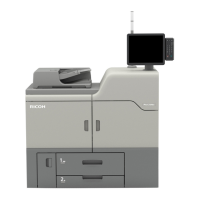6. Enter the name of the paper.
You can enter up to 38 half-width characters. You can register Different Custom Paper under
the same name.
7. Press [Paper Size].
8. Select a paper size.
9. Press [Paper Weight].
10. Specify the paper's weight.
You can also specify [Paper Thickness].
11. Press [Paper Type].
12. Specify the paper type.
13. Specify other items, such as [Coated Paper Type], [Paper Color], [Prepunched],
[Textured], [Apply Duplex], and [Apply Auto Paper Select] as necessary.
14. Press [Save Paper].
The [Save Custom Paper] screen is displayed.
If you change the [Paper Weight], [Paper Type], [Coated Paper Type], [Paper Color],
[Prepunched], or [Textured] and press [OK], a message appears to notify you that the
[Advanced Settings] will be initialized. To apply the changes for those settings, select
[Change]. To cancel the changes, select [Do not Change].
15. Press [Save].
16. Press [Program].
17. Press [Exit].
Custom paper is saved under the smallest unregistered number.
18. Press .
19. Press the [Home] ( ) icon at the center bottom of the screen.
• If you want to use glossy paper, select [Coated: Glossy] or [Coated: High Gloss] for [Coated
Paper Type]. If you want to use matte paper (including silk, dull, and satin paper), select
[Coated: Matte] for [Coated Paper Type].
• For details about custom paper settings, see page 57 "Custom Paper Settings".
• For details about [Advanced Settings], contact your machine administrator.
Registering a new custom paper by modifying an existing paper
You can open and modify the settings of a registered custom paper and register them as a new custom
paper.
3. Useful Functions
48

